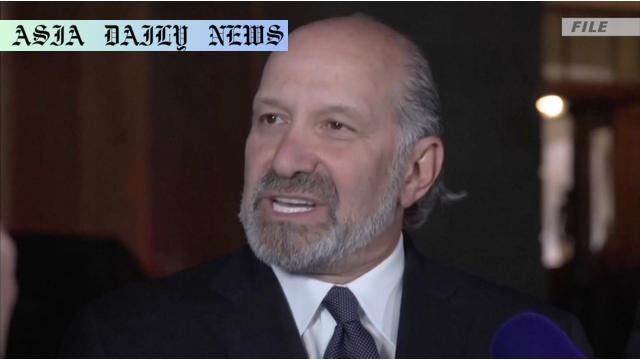Trade Talks: US Commerce Secretary Howard Lutnick signals early August negotiations with China to ease trade tensions.
Trade Talks between US and Chinese officials expected in early August.
Commerce Secretary Howard Lutnick will be joined by key representatives.
Trump administration hopes for improved bilateral relations, despite previous tariffs.
Discussions revolve around easing tensions on rare earth exports and tariffs.

Introduction: The Road to US-China Trade Talks
The global economy watches with bated breath as US Commerce Secretary Howard Lutnick hints at the possibility of key trade discussions with Chinese negotiators scheduled for early August. This marks yet another pivotal moment in the ongoing saga of trade tensions between two of the world’s largest economies. Lutnick, alongside prominent figures such as US Treasury Secretary Scott Bessent and Trade Representative Jamieson Greer, will endeavor to forge compromises and address long-standing trade disputes. Given the backdrop of tariff wars and strained relations, these talks hold immense significance in charting the future trajectory of US-China economic interplay.
Background and Context
Earlier in 2023, the Trump administration initiated steep tariffs on Chinese goods, a move Beijing reciprocated with equal fervor. Both countries levied over 100% tariffs on each other’s products, resulting in heightened economic friction. However, recognizing the mutual detriment these measures inflicted, the two nations agreed in May to scale back tariffs temporarily and resume constructive trade dialogues. This 90-day negotiation window, set to conclude by mid-August, underscores the urgency with which both sides are addressing unresolved trade disputes.
Key Focus Areas in Upcoming Negotiations
The talks will likely revolve around sensitive issues such as export restrictions on rare earth metals—a critical point of contention that has ramifications extending far beyond the US and China’s bilateral relationship. China’s recent declaration of willingness to expedite the review and approval of export applications marks a promising development. Additionally, discussions may touch on intellectual property rights, digital trade regulations, and mechanisms to ensure fair competition. Both nations aim to strike a balance that safeguards their economic interests while fostering long-term collaboration.
The Broader Economic Implications
A resolution to US-China trade tensions could potentially herald a new era of stability in global markets. With supply chains heavily intertwined between the two powers, any improvement in their trade dynamic would alleviate existing pressures on international industries. Conversely, a failure to reach consensus may exacerbate uncertainties, further complicating recovery efforts amidst fluctuating global economic conditions.
Conclusion: A Crucial Moment in Economic Diplomacy
As the world’s leading economies prepare for the August trade talks, all eyes remain on the outcomes of these discussions. The stakes are undeniably high, as both nations have much to gain from reestablishing trust and cooperation. Success in these negotiations could signify not only a thaw in bilateral relations but also a ripple effect fostering global economic stability. Stakeholders across industries will keenly follow updates, hoping for a resolution that benefits both sides and the broader international community.



Commentary
US-China Trade Talks: A Crucial Step Forward
The announcement of potential trade discussions between the US and China comes as a breath of fresh air amidst a turbulent economic landscape. Both nations have found themselves at odds concerning tariffs, regulations, and trade imbalances. However, in an increasingly interdependent global economy, prolonged disputes only serve to alienate stakeholders and stymie growth. It is heartening to observe that leaders on both sides are willing to come to the negotiation table and, hopefully, chart a path towards mutual benefit.
The Strategic Importance of Rare Earth Exports
One of the focal points of these trade discussions is undoubtedly the issue of rare earth exports—an area in which China holds significant influence. Rare earth metals are indispensable for a multitude of industries, including technology, defense, and renewable energy. The willingness of the Chinese government to review and expedite export applications is a positive signal for US-based businesses reliant on these materials. Such gestures of goodwill pave the way for deeper cooperation and tangible outcomes in the forthcoming talks.
The Need for a Long-Term Vision
While these upcoming talks bring a sense of optimism, it is essential to recognize that resolving trade tensions requires more than short-term agreements. Both nations need to adopt a long-term vision that prioritizes sustainable economic collaboration and minimizes the risk of future conflicts. This necessitates transparency, mutual respect, and a commitment to fairness. Only then can the US and China unlock the full potential of their economic partnership.
Looking Ahead
As we await the outcomes of the August trade talks, it is imperative for policymakers, businesses, and the global community to remain patient and hopeful. The significance of these discussions extends beyond the borders of the US and China, influencing the broader international landscape. Regardless of the challenges that lie ahead, these talks serve as a testament to the power of dialogue in addressing even the most complex issues. Let us hope that August marks the beginning of a stronger and more cooperative chapter in US-China relations.